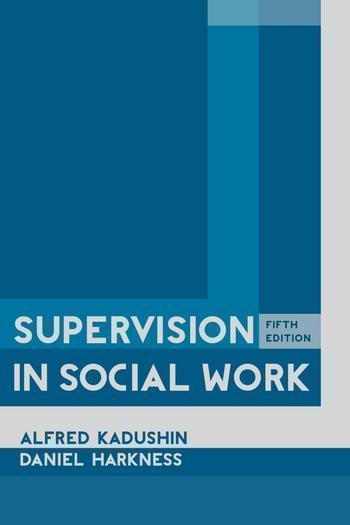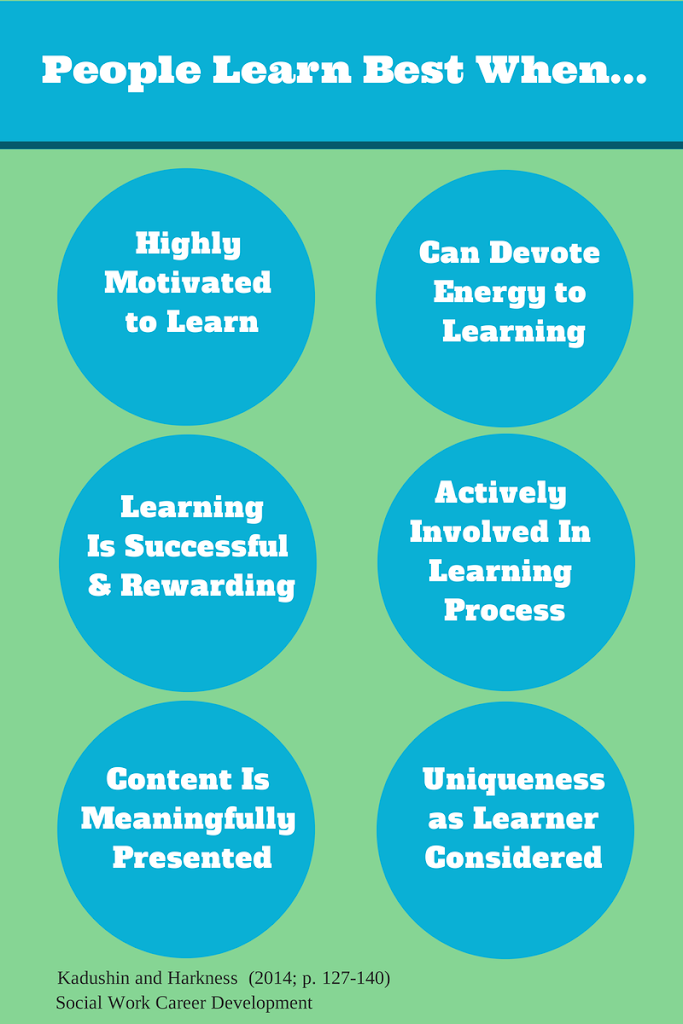Are you looking for a good resource to prepare you to take on the role of social work supervisor? Or perhaps you are an educator looking for an excellent book about supervision to use in your advanced practice class?
If yes, Supervision in Social Work, Fifth Edition, by Alfred Kadushin and Daniel Harkness may be the perfect book to fulfill your needs!
Kadushin and Harkness (2014) provide you with a thorough review of supervision, starting with how it originated, the different types, to recent innovations in the field (such as live supervision). Furthermore, you are alerted about the typical challenges and issues that arise when you become a supervisor and are guided in the art of social work supervision.
As you can see in the below chart, social work supervision has 3 roles: administrative, educational and supportive.
Individuals Learn Best Under the Following Conditions
How May Supervisors Optimize These 6 Conditions?
To Increase Motivation to Learn:
- Explain usefulness of content
- Make content meaningful in terms of worker’s specific needs and motives (What’s in it for worker?)
- Stimulate interest
- Provide structure (in terms of time, place, obligations, expectations etc)
- Establish safe & secure atmosphere
- Acknowledge and use what worker knows and can do
- Move from known to unknown
- Respect worker’s rights (within limits) to determine own solutions
- Provide learning in digestible dosages
- Give positive feedback
- Present content from simple/obvious to complex/obscure
- Evaluate progress over time
- Encourage worker’s participation in setting agenda
- Encourage discussion
- Provide opportunities to use knowledge
- Select content that interests the worker
- Present content within a theoretical framework (to help her/him understand why people do what they do in the way they do it)
- Plan your teaching
- Teach selectively (have priorities)
- Use educational diagnosis (what knowledge and skills this worker needs)
- Apply educational diagnosis
- Engage worker in assessment
- Consider worker’s pace
There are many additional valuable nuggets to gleam from this book!
In sum, I found the Supervision in Social Work book to be an excellent reference on supervision, whether you are an experienced or newbie clinician. For example, the chapter that has been referenced above pertaining to how you may improve your educational supervisory skills, is one section that is likely to be of great value to even the most seasoned practitioner.
One item that was not included in the book but could have provided some additional texture was a video/dvd component. I would have loved to have had the opportunity to listen to or watch the group supervision illustration Kadushin and Harkness described, albeit eloquently.
What are your thoughts about the supervision process? Please write your comments below.
Did you find this post helpful? If yes, could you please “share” it with others? Thanks.
Disclosure of Material Connection: I received one copy of the book mentioned above for free in the hope that I would mention it on my blog. In addition, the link to this book is an “affiliate link.” Regardless, I only recommend products or services I use personally and believe will be good for my readers. I am disclosing this in accordance with the Federal Trade Commission’s 16 CFR, Part 255: “Guides Concerning the Use of Endorsements and Testimonials in Advertising.”




Dorlee,
What a richly woven post!
I really liked this: “How May Supervisors Optimize These 6 Conditions?” Listing the ‘hows’ seems to illuminate the coaching aspects of a successful supervisor: ‘teaching, edifying, stimulating, providing positive feedback, and customizing actions to individual subordinates’ styles,’ among many more suggestions. While a great supervisor from time to time must correct and reprimand, an excellent supervisor knows how to make that a small part of their role. Their larger impact and purpose is individually elevating their staff and enabling their momentum and success.
The description of what makes a good social work supervisor seems to mirror what I hear from clients every day what makes for an effective leader across many industries.
Nicely articulated, as always!
Jacqui
Thanks so much, Jacqui, for your kind and insightful feedback on this post.
You’ve noted and highlighted the key coaching aspects that are involved in any coaching/mentoring relationship (not just one of a social work supervisor to social worker supervised).
Often times, when we are coaching a client, we may find ourselves focusing on a few of these areas but neglect (or forget) about the significance of the other areas. Seeing the graphic and corresponding notes may serve as a gentle reminder for us all to keep all these perspectives in mind in order to motivate and bring out the best in our clients/supervisees.
With much appreciation,
Dorlee
Hi, Dorlee! I’m getting to this post late but wanted to thank you for reviewing this book on supervision. So many times mental health professionals who have really great clinical skills believe that because they are good with their clients, that they must also be good at clinical supervision.
Research has consistently shown that while there is overlap in skill sets for clinical work and clinical supervision, there is also an entirely different set of skills that is also needed for effective supervision to take place.
I know in the field of counseling, the trend is for clinical supervisors to have additional formal training in supervision. I wonder if that is true for the field of social work, too . . . . Are clinical supervisors in social work expected to have formal training beyond their master’s level training?
Hi Tamara,
Thanks so much for stopping by and sharing your thoughts about supervision,
I agree with you that obtaining training and/or guidance about supervision is invaluable. In terms of the process for clinical social workers, after you graduate with an MSW, you take the LMSW exam and work with clients under supervision of a LCSW social worker, psychologist or psychiatrist in an approved facility for a minimum of 3 years (certain number of clinical hours with supervision). After you have met these requirements, you take another exam – LCSW in NY and you’re then allowed to work directly with clients sans supervision.
With regards to supervising other social workers, some schools and organizations provide structured supervisory training. In addition, some social workers will intentionally seek out a mentor for guidance.
An experienced colleague will also be stepping in shortly to address your question.
Thanks again!
Dear Tamara (1 of 2),
I strongly agree with the premised of your question regarding clinical supervision. I’m referring specifically to the belief that mental health professionals who have excellent clinical skills with their clients, “must” also be good at clinical supervision. I think that they may or may not be good clinical supervisors.
Many factors are involved from my perspective. One would be how seriously the supervisor takes this responsibility, how much time they spend preparing for a supervision session and for supervision in general. The understanding of the supervision process, on the part of the supervisee and their ability to be open about doubts or concerns they have about their work with a specific client or in general, is also a significant factor in how effective the supervision process can be.
If the supervisee, for example, sees the supervisor as someone with enormous “power over them,” they are likely to be very closed and withholding during supervision which can turn supervision into more of a “power struggle” than an opportunity to learn and improve one’s knowledge and skills. So, the research findings that you summarized seem very logical to me, and completely consistent with my perspective, as stated above.
I have been a clinical supervisor, which first requires having an LCSW. The supervisee is typically known as P-LCSW. I attended the North Carolina Social Work Certification and Licensure Board’s Supervision Certification course. It was 3 full days long; something to the order of 8:00 A.M – 5:00P.M. with time off for lunch, which they provided, as I recall.
One does need to pay for the course, and since I attended mine in June 2007 in Charlotte, North Carolina, I also paid for a hotel and travel expenses. I feel that it was an expenditure well worthwhile! They had a good number of presenters over the course of the 3 days, and I generally found them to be knowledgeable, spoke about relevant issues, and had good presentation styles, keeping their material clear, understandable and presenting it with considerable passion!
Among the presenters there, as best I recall, was the then current Board Chair, and he spoke powerfully about ethics issues, boundary issues and the extreme importance of establishing and maintaining strong boundaries with one’s clients. He specifically spoke about the fact that having any type of sexual relationship with a client or supervisee is strictly prohibited, and that the Board has ways of watching out for such occurrence, and that any complaint filed would be fervently investigated until a determination of its substantiation or non-substantiation were made. If any allegation was found to be true, that social worker was expelled from the profession, without any opportunity to return.
Ernest A. Wahrburg, MSW, LCSW
Dear Tamara (2 of 2),
Another presenter that I recall was the current Board Vice Chair, and her presentation also focused a lot on ethics. So many topics were covered it really wouldn’t even be feasible to attempt to include them all. Among some I recall, one is that 100 hours (minimum) of supervision must be provided to the P-LCSW licensee, must be done face to face and cannot include telephone or online communication.
Twenty-five of the 100 hours may be group supervision. The appropriate use of the supervision hour was also discussed. It should include a review of cases by the supervisee, including assessment and diagnosis, interventions used, theoretical rationale for the intervention, and outcome of each intervention.
Issues of transference and counter-transference should also be discussed, as well as sexual attraction and boundaries. Supervisors should also regularly review documentation included in the files of the supervisee’s clients for clarity, relevance, description of what was discussed by client, what interventions were made, and any mention of any substantial change in mental status.
Within the Supervisor Manual provided to the conference’s attendees, Sample Emergency Crises Plans, Sample Supervisory Agreements and Log, a bibliography of supervision literature, continued education requirements were all included, plus much more!!!
As I’m sure is evident, the certification class is rigorous, extremely detailed, presented in a very serious and professional manner and I perceived it to be exhaustive in what it covered.
There was also a take home test to be completed and returned to the Board by a specific date, which the Board reviewed and determined if the test was passed or not. If passed, one received their certification for clinical supervision, as per the North Carolina Social Work Certification and Licensure Board. Fortunately, I did pass!
Thank you for asking the question Tamara. I sincerely liked and benefited from thinking and reading about clinical supervision again!!
Ernest A. Wahrburg, MSW, LCSW
Thanks so much, Ernest, for sharing your experience about being formally trained and certified in supervision. I most appreciated your detailed description.
I hadn’t known that there was this type of supervision training/certification available. It sounds like it was most beneficial and that all clinical social workers in the role of supervisors would benefit from it.
Thanks again for your expert guidance!
I dropped in last week but wasn’t able to leave a comment so I’m trying again. Thanks so much for taking so much time to explain training in clinical supervision for social workers. It sounds . . . Intentse!